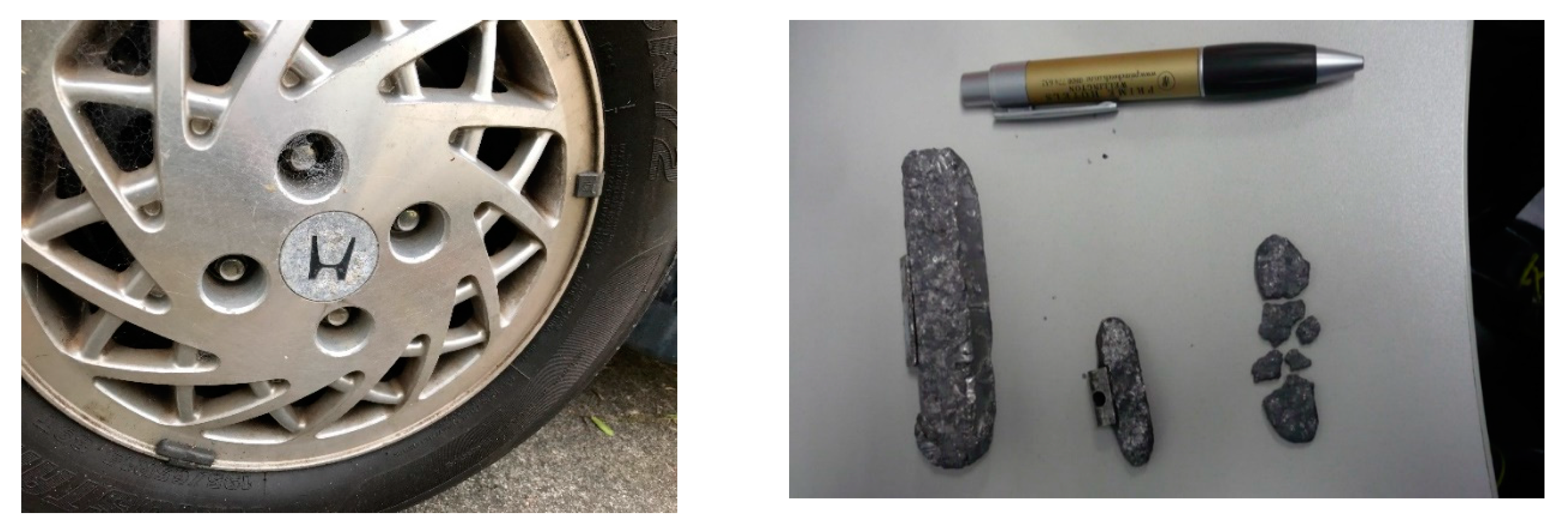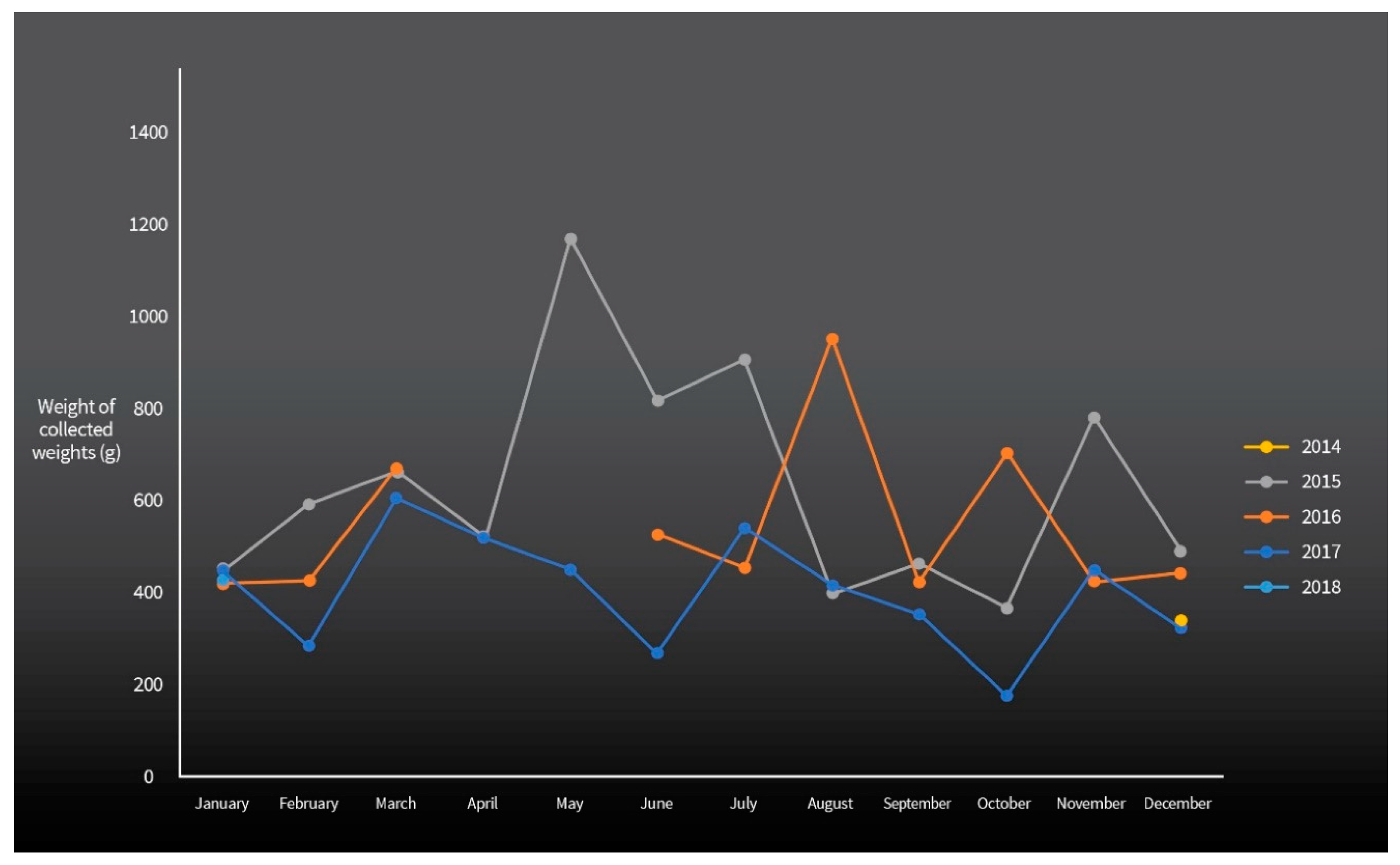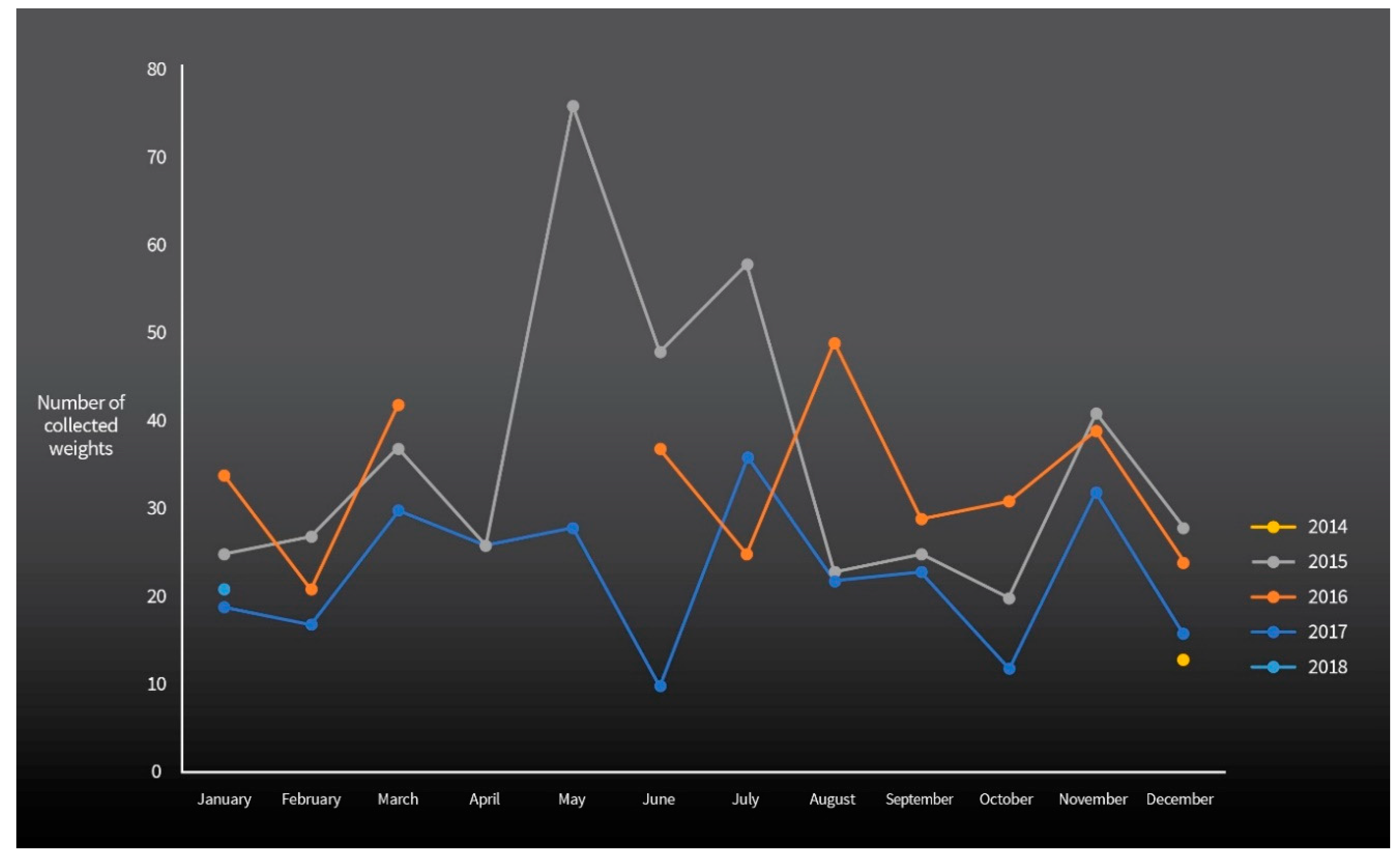Tyre Weights an Overlooked Diffuse Source of Lead and Antimony to Road Runoff
Abstract
1. Introduction
2. Materials and Methods
3. Results
3.1. Mass and Number of Weights
3.2. Influence of Traffic Density and Street Type
4. Discussion
5. Conclusions
Author Contributions
Funding
Acknowledgments
Conflicts of Interest
References
- US Food and Drug Administration. Q3D Elemental Impurities Guidance for Industry; US Department of Health and Human Services: Washington, DC, USA, 2015; p. 41.
- Buekers, J.; Redeker, E.S.; Smolders, E. Lead toxicity to wildlife: Derivation of a critical blood concentration for wildlife monitoring based on literature data. Sci. Total Environ. 2009, 407, 3431–3438. [Google Scholar] [CrossRef]
- Hjortenkrans, D.; Bergbäck, B.; Häggerud, A. New metal emission patterns in road traffic environments. Environ. Monit. Assess. 2006, 117, 85–98. [Google Scholar] [CrossRef]
- Bleiwas, D.I. Stocks and Flows of Lead-Based Wheel Weights in the United States; US Geological Survey Open-File Report, 1111(6); U.S. Geological Survey: Reston, VA, USA, 2006.
- Root, R. Lead Loading on Urban Streets by Motor Vehicle Wheel Weights. Environ. Health Perspect. 2000, 108, 937–940. Available online: https://ehp.niehs.nih.gov/doi/pdf/10.1289/ehp.00108937 (accessed on 20 August 2020). [CrossRef] [PubMed]
- Root, R.A. Analysis of a study of lead wheel weight deposition and abrasion in New Jersey. Water Air Soil Pollut. 2015, 226, 381. [Google Scholar] [CrossRef][Green Version]
- Filippelli, G.M.; Risch, M.; Laidlaw, M.A.; Nichols, D.E.; Crewe, J. Geochemical legacies and the future health of cities: A tale of two neurotoxins in urban soils. Elem. Sci. Anth. 2015, 24, 000059. [Google Scholar] [CrossRef]
- Laidlaw, M.A.; Zahran, S.; Pingitore, N.; Clague, J.; Devlin, G.; Taylor, M.P. Identification of lead sources in residential environments: Sydney Australia. Environ. Pollut. 2014, 184, 238–246. [Google Scholar] [CrossRef]
- Sriram, A.; Roe, W.; Booth, M.; Gartrell, B. Lead exposure in an urban, free-ranging parrot: Investigating prevalence, effect and source attribution using stable isotope analysis. Sci. Total Environ. 2018, 634, 109–115. [Google Scholar] [CrossRef]
- Johnson, F.M. The genetic effects of environmental lead. Mutat. Res. Rev. Mutat. 1998, 410, 123–140. [Google Scholar] [CrossRef]
- Mielke, H.W. Lead in the inner cities: Policies to reduce children’s exposure to lead may be overlooking a major source of lead in the environment. Am. Sci. 1999, 87, 62–73. [Google Scholar] [CrossRef]
- Arai, Y. Arsenic and Antimony. In Trace Elements in Soils; Hooda, P.S., Ed.; Blackwell Publishing: Chichester, UK, 2010; pp. 383–407. [Google Scholar]
- Wilson, S.; Lockwood, P.; Ashley, P.; Tighe, M. The chemistry and behaviour of antimony in the soil environment with comparisons to arsenic: A critical review. Environ. Pollut. 2010, 158, 1169–1181. [Google Scholar] [CrossRef]
- Filella, M.; Belzile, N.; Chen, Y.W. Antimony in the environment: A review focused on natural waters: I. Occurrence. Earth Sci. Rev. 2002, 57, 125–176. [Google Scholar] [CrossRef]
- Cal-Prieto, M.J.; Carlosena, A.; Andrade, J.M.; Martinez, M.L.; Muniategui, S.; Lopez-Mahia, P.; Prada, D. Antimony as a tracer of the anthropogenic influence on soils and estuarine sediments. Water Air Soil Pollut. 2001, 129, 333–348. [Google Scholar] [CrossRef]
- Sternbeck, J.; Sjödin, Å.; Andréasson, K. Metal emissions from road traffic and the influence of resuspension—Results from two tunnel studies. Atmos. Environ. 2002, 36, 4735–4744. [Google Scholar] [CrossRef]
- Carrero, J.A.; Arrizabalaga, I.; Bustamante, J.; Goienaga, N.; Arana, G.; Madariaga, J.M. Diagnosing the traffic impact on roadside soils through a multianalytical data analysis of the concentration profiles of traffic-related elements. Sci. Total Environ. 2013, 458, 427–434. [Google Scholar] [CrossRef]
- Laidlaw, M.A.; Mohmmad, S.M.; Gulson, B.L.; Taylor, M.P.; Kristensen, L.J.; Birch, G. Estimates of potential childhood lead exposure from contaminated soil using the US EPA IEUBK Model in Sydney, Australia. Environ. Res. 2017, 156, 781–790. [Google Scholar] [CrossRef]
- Hjortenkrans, D. Road Traffic Metals: Sources and Emissions. Ph.D. Thesis, University of Kalmar, Kalmar, Sweden, 2008. [Google Scholar]
- Chlopecka, A.; Bacon, J.R.; Wilson, M.J.; Kay, J. Forms of cadmium, lead, and zinc in contaminated soils from southwest Poland. J. Environ. Qual. 1996, 25, 69–79. [Google Scholar] [CrossRef]
- Lee, P.-K.; Touray, J.C.; Baillif, P.; Ildefonse, J.P. Heavy metal contamination of settling particles in a retention pond long the A-71 motorway in Sologne, France. Sci. Total Environ. 1997, 201, 1–15. [Google Scholar] [CrossRef]
- Fiala, M.; Hwang, H.M. Development of a Static Model to Identify Best Management Practices for Trace Metals from Non-Exhaust Traffic Emissions. Environ. Process. 2019, 6, 377–389. [Google Scholar] [CrossRef]
- Campbell, P.M.; Corneau, E.; Nishimura, D.; Teng, E.; Ekoualla, D. Cost-benefit analysis for a lead wheel weight phase-out in Canada. Sci. Total Environ. 2018, 637, 79–90. [Google Scholar] [CrossRef] [PubMed]
- Aucott, M.; Caldarelli, A. Quantity of lead released to the environment in New Jersey in the form of motor vehicle wheel weights. Water Air Soil Pollut. 2012, 223, 1743–1752. [Google Scholar] [CrossRef]
- Hamilton City Council. Hamilton 2015 Traffic Flow Map Average Daily (24hrs) Traffic Volume. Available online: http://www.hamilton.govt.nz/our-services/transport/maintainingimproving/Documents/2015%20Traffic%20Flow%20Map.pdf (accessed on 20 August 2020).
- Land Transport New Zealand. Contaminant Characterization and Toxicity of Road Sweepings and Catchpit Sediments: Towards More Sustainable Reuse Options; Land Transport New Zealand Research Report 345; Land Transport New Zealand: Wellington, New Zealand, 2008.
- Pandey, S.; Taylor, M.D.; Lee, R. Reduction of Road Run Off Contaminants: Laboratory Experiments and Monitoring of Treatment Walls; Land Transport New Zealand: Wellington, New Zealand, 2005.
- Ministry of Transport. Infrastructure and Investment: Infrastructure Size 2015. Available online: https://www.transport.govt.nz/mot-resources/transport-dashboard/2-road-transport/ (accessed on 20 August 2020).
- De Silva, S.; Ball, A.S.; Huynh, T.; Reichman, S.M. Metal accumulation in roadside soil in Melbourne, Australia: Effect of road age, traffic density and vehicular speed. Environ. Pollut. 2016, 208, 102–109. [Google Scholar] [CrossRef] [PubMed]
- Rodriguez-Flores, M.; Rodriguez-Castellon, E. Lead and cadmium levels in soil and plants near highways and their correlation with traffic density. Environ. Pollut. B 1982, 4, 281–290. [Google Scholar] [CrossRef]
- Gómez, D.R.; Giné, M.F.; Bellato, A.C.S.; Smichowski, P. Antimony: A traffic-related element in the atmosphere of Buenos Aires, Argentina. J. Environ. Monit. 2005, 7, 1162–1168. [Google Scholar] [CrossRef] [PubMed]
- Bukowiecki, N.; Lienemann, P.; Hill, M.; Figi, R.; Richard, A.; Furger, M.; Rickers, K.; Falkenberg, G.; Zhao, Y.; Cliff, S.S.; et al. Real-world emission factors for antimony and other brake wear related trace elements: Size-segregated values for light and heavy duty vehicles. Environ. Sci. Technol. 2009, 43, 8072–8078. [Google Scholar] [CrossRef] [PubMed]
- Thorpe, A.; Harrison, R.M. Sources and properties of non-exhaust particulate matter from road traffic: A review. Sci. Total Environ. 2008, 400, 270–282. [Google Scholar] [CrossRef] [PubMed]
- Weckwerth, G. Verification of traffic emitted aerosol components in the ambient air of Cologne (Germany). Atmos. Environ. 2001, 35, 5525–5536. [Google Scholar] [CrossRef]
- Fujiwara, F.; Rebagliati, R.J.; Marrero, J.; Gómez, D.; Smichowski, P. Antimony as a traffic-related element in size-fractionated road dust samples collected in Buenos Aires. Microchem. J. 2011, 97, 62–67. [Google Scholar] [CrossRef]
- Gietl, J.K.; Lawrence, R.; Thorpe, A.J.; Harrison, R.M. Identification of brake wear particles and derivation of a quantitative tracer for brake dust at a major road. Atmos. Environ. 2010, 44, 141–146. [Google Scholar] [CrossRef]
- Ozaki, H.; Watanabe, I.; Kuno, K. As, Sb and Hg distribution and pollution sources in the roadside soil and dust around Kamikochi, Chubu Sangaku National Park, Japan. Geochem. J. 2004, 38, 473–484. [Google Scholar] [CrossRef]
- Alloway, B.J. Copper and Zinc in Soils: Too Little or Too Much? Paper Presented to the New Zealand Trace Elements Group Conference, University of Waikato, 13–15 February 2008. Available online: http://www.tracenz.net/conference2008/NZTEG2008_001.html (accessed on 20 August 2020).
- Chaney, R.L. Cadmium and zinc. In Trace Elements in Soils; Hooda, P.S., Ed.; Blackwell Publishing: Chichester, West Sussex, UK, 2010; pp. 409–440. [Google Scholar]
- Councell, T.B.; Duckenfield, K.U.; Landa, E.R.; Callender, E. Tire-wear particles as a source of zinc to the environment. Environ. Sci. Technol. 2004, 38, 4206–4214. [Google Scholar] [CrossRef]
- Vermeulen, V. Use of Zinc in Agriculture: An Assessment of Data for Evidence of Accumulation in Waikato Soils, Surface Water and Sediments. Master’s Thesis, Massey University, Wellington, New Zealand, 2015. [Google Scholar]
- Wallström, M. COMMISSION DECISION of 27 June 2002 Amending Annex II of Directive 2000/53/EC of the European Parliament and of the Council on End-of-Life Vehicles (Notified under Document Number C (2002) 2238). 2002. Available online: http://eur-lex.europa.eu/LexUriServ/LexUriServ.do?uri=OJ:L:2002:170:0081:0084:EN:PDF (accessed on 20 August 2020).
- Modern Tire Dealer. New Jersey Sets Six Months to Comply with Lead Wheel Weight Ban. Published on January 18, 2018. Available online: https://www.moderntiredealer.com/news/728134/new-jersey-sets-six-months-to-comply-with-lead-wheel-weight-ban (accessed on 20 August 2020).
- Modern Tire Dealer. Maryland Passes Lead Wheel Weight Law. Published on May 9, 2017. Available online: http://www.moderntiredealer.com/news/722352/maryland-passes-lead-wheel-weight-law (accessed on 20 February 2018).




| Road Segment | Type | Length (m) | Area (m2) | Vehicle Movements Per Day [25] |
|---|---|---|---|---|
| Colquhoun Pl. | Residential | 138 | 966 | 100 |
| Aberdeen Dr. | Residential | 1005 | 7035 | 1000 |
| Riflerange Rd. | Residential | 855 | 5985 | 10,000 |
| Norton Rd. | Main road | 1410 | 9870 | 14,000 |
| Founders roundabout | Major intersection or roundabouts | 594 | 6237 | 20,000 * |
| Seddon Rd/Ward St. | Steep curve, following a valley bottom. Intersecting streets are descending on to Seddon St. Traffic often start stop. | 732 | 5124 | 7000 |
| Tristham St. and Cobham Dr. | Major intersection or roundabouts | 1495 | 10,465 | 18,000 |
| Anzac Pd. | Main road | 682 | 4774 | 25,000 |
| Road Segment | Classification | Vmd * (Hamilton City Council, 2015) | Length [km] | Number of Weights Collected | Number of Weights Collected/km | Number of Weights Collected/vmd |
|---|---|---|---|---|---|---|
| Colquhoun Pl. | Residential | 100 | 0.14 | 0 | 0 | 0 |
| Aberdeen Dr. | Residential | 1000 | 1.00 | 4 | 4 | 4 |
| Riflerange Rd. | Residential | 10,000 | 0.85 | 30 | 35 | 3 |
| Norton Rd. | Main road | 14,000 | 1.40 | 145 | 103 | 10.4 |
| Founders roundabout Norton Rd exit | Major intersection or roundabouts | 20,000 | 0.60 | 184 | 310 | 9.2 |
| Seddon Rd/Ward St. | Steep curve, following a valley bottom. Intersecting streets are descending on to Seddon St. Traffic often start stop. | 7000 | 0.73 | 113 | 154 | 16.1 |
| Cobham Dr. And Tristham St. | Major intersection or roundabouts | 18,000 | 1.50 | 328 | 219 | 18.2 |
| Anzac Pd. | Main road | 25,000 | 0.68 | 52 | 76 | 2.1 |
| Source, Street Structure | Average Pb kg/km/y | Traffic Density (vmd) |
|---|---|---|
| Average for this study | 0.78 | 9700 |
| [5] six lane arterial road | 8.65 | 45,000 |
| [24] Commercial | 0.49 | - |
| [24] Mixed use | 0.08 | - |
| [24] Connector | 0.02 | - |
| [24] Heavy and intersection | 7.5 | 15,000–20,000 [5] |
| [4] | 0.29 | - |
| [23] | 0.12 | - |
| [22] | 0.62 | - |
© 2020 by the authors. Licensee MDPI, Basel, Switzerland. This article is an open access article distributed under the terms and conditions of the Creative Commons Attribution (CC BY) license (http://creativecommons.org/licenses/by/4.0/).
Share and Cite
Taylor, M.; Kruger, N. Tyre Weights an Overlooked Diffuse Source of Lead and Antimony to Road Runoff. Sustainability 2020, 12, 6790. https://doi.org/10.3390/su12176790
Taylor M, Kruger N. Tyre Weights an Overlooked Diffuse Source of Lead and Antimony to Road Runoff. Sustainability. 2020; 12(17):6790. https://doi.org/10.3390/su12176790
Chicago/Turabian StyleTaylor, Matthew, and Niklas Kruger. 2020. "Tyre Weights an Overlooked Diffuse Source of Lead and Antimony to Road Runoff" Sustainability 12, no. 17: 6790. https://doi.org/10.3390/su12176790
APA StyleTaylor, M., & Kruger, N. (2020). Tyre Weights an Overlooked Diffuse Source of Lead and Antimony to Road Runoff. Sustainability, 12(17), 6790. https://doi.org/10.3390/su12176790





